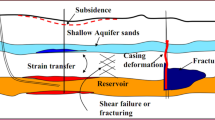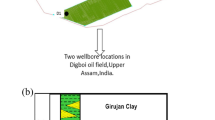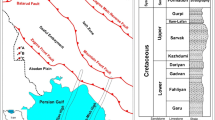Abstract
Reservoir geomechanical studies play a decisive role in identifying wellbore instability and weak zones in offshore petroleum reservoirs. In this study, an integrated workflow developed with 1D Mechanical Earth Models (1D MEM), uniaxial compressive strength and swelling tests using well logs, drilling, and core data of production and exploratory wells from the North-Heera field, Mumbai offshore, India. Lithology-based correlations are utilized for calculating continuous profiles of rock mechanical properties by taking well logs as a primary source of input. Insights of fracture gradients and stresses are generated by interpretation of the pore pressure. UCS created from the well logs shows the low value of 15 MPa and high Poison's ratio of 0.38–0.45. Fracture pressure analysis of the wells specifies the lower fracture initiation pressures at 300 m are 5ppg–15ppg, which are shale and clay formation. Shale swelling tests are performed to know the hydration properties of shales present at shallow depths. The core samples' loading tests' results are very close to the UCS models constructed from the well logs. The combined analysis examines fracture pressures around wellbores, hydration of shales, weak zones identification, and wellbore instability.



















Similar content being viewed by others
Abbreviations
- 1D:
-
One dimensional
- 3D:
-
Three dimensional
- ONGC:
-
Oil and Natural Gas Corporation Limited
- DGH:
-
Director general of hydrocarbons
- MD:
-
Measured depth
- PPG:
-
Pounds per Gallon
- TVD:
-
True vertical depth
- TVD-RT:
-
True vertical depth from rotary table
- LOT:
-
Leak-off test
- PR:
-
Poison’s ratio
- UCS:
-
Unconfined compressive strength
- IFC:
-
Internal friction coefficient
- YM:
-
Young’s modulus
- CAPEX:
-
Capital expenditure
- OPEX:
-
Operating expenditure
- NCT:
-
Normal compaction trend
- σv :
-
Vertical stress
- σw :
-
Vertical load by water column
- σo :
-
Vertical load at the point where the density log began
- ρ:
-
Density
- α:
-
Biot’s constant
- Pp :
-
Pore pressure
- E:
-
Young’s modulus
- Ɛx :
-
Compressional horizontal strain (x-direction)
- Ɛy :
-
Extensional horizontal strain(y-direction)
- FIT:
-
Formation Integrity Test
- Gdyn :
-
Dynamic Bulk modulus
- νdyn :
-
Dynamic Poison’s ratio
- Edyn :
-
Dynamic Young’s modulus
- Vp :
-
P-wave Velocity
- Vs :
-
S- wave Velocity
- Estatic :
-
Static Young’s modulus
- UCSlimestone :
-
Unconfined compressive strength of limestone
- UCSshale :
-
Unconfined compressive strength of shale
- Ø:
-
Internal friction coefficient
- MPa:
-
Mega Pascal
- GPa:
-
Giga Pascal
- YF:
-
Yellow Fluorescence
- GYF:
-
Green Yellow Fluorescence
- Pf :
-
Fracture Pressure
- ν:
-
Poison’s ratio
- FS:
-
Free Swell
- V:
-
Final Volume
- V° :
-
Initial Volume
- Dn:
-
Density
- Ω:
-
Resistivity
References
Xia, L.W.; Cao, J.; Wang, M.; Mi, J.L.; Wang, T.T.: A review of carbonates as hydrocarbon source rocks: basic geochemistry and oil–gas generation. Petr. Sci. 16, 713–728 (2019). https://doi.org/10.1007/s12182-019-0343-5
Du, H.; Radonjic, M.; Olabode, A.O.: Impact of clay mineralogy on geomechanics of shale caprocks. 51st US Rock Mech Geomech. Symp. 4, 2580–2586 (2017)
Al-Awad, M.N.J.; Smart, B.G.D.: Characterization of shale-drilling fluid interaction mechanisms related to wellbore instability. J. King Saud Univ. Eng. Sci. 8, 187–214 (1996). https://doi.org/10.1016/s1018-3639(18)30657-3
Bybee, K.: Wellbore strengthening in shale. J. Pet. Technol. 60, 71–72 (2008). https://doi.org/10.2118/0108-0071-JPT
Russell, K.A.; Ayan, C.; Hart, N.J.; Rodriguez, J.M.; Scholey, H.; Sugden, C.; Davidson, J.K.: Predicting and preventing wellbore instability: Tullich field development North Sea. SPE Drill. Complet. 21, 12–21 (2006)
Cheatham, J.B.: Distinguished author series wellbore stability. J. Pet. Technol. 36, 889–896 (1984)
Al-Awad, M.N.J.; Smart, B.G.D.: Modified failure criterion for shales. Rock Char. Model. Eng. Des. Methods 5, 297–302 (2013)
Santos, H.; Diek, A.; da Fontoura, S.; J.C.R. : shale reactivity test: a novel approach to evaluate shale-fluid interaction. Int. J. Rock Mech. Min. Sci. 34, 268.e1-268.e11 (1997). https://doi.org/10.1016/s1365-1609(97)00125-1
Pašić, B.; Gaurina-Medimurec, N.; Matanović, D.: Wellbore instability: causes and consequences. Rud. Geol. Naft. Zb. 19, 87–98 (2007)
Alkamil, E.H.K.; Abbood, H.R.; Flori, R.E.; Eckert, A.: Case study of wellbore stability evaluation for the Mishrif Formation. Iraq. J. Pet. Sci. Eng. 164, 663–674 (2018). https://doi.org/10.1016/j.petrol.2018.01.018
Abousleiman, Y.; Tran, M.; Hoang, S.; Bobko, C.; Ortega, A.; Ulm, F.J.: Geomechanics field and laboratory characterization of woodford shale: the next gas play. Proc. SPE Annu. Tech. Conf. Exhib. 4, 2127–2140 (2007)
Cuervo, S.; Adachi, J.; Lombardo, E.: Integration of 1D and 3D mechanical Earth models in oil shale plays. An example from the Vaca Muerta formation (Argentina). In: 52nd U.S. Rock Mechanics Symposium (2018)
Bybee, K.: Mitigating wellbore stability problems of water-based muds. J. Pet. Technol. 54, 61–62 (2002). https://doi.org/10.2118/1002-0061-JPT
Parkash, D.; Deangeli, C.: Wellbore stability analysis in anisotropic shale formations. In: SPE/PAPG Pakistan Section Annual Technical Symposium and Exhibition, pp. 18–20. Society of Petroleum Engineers (2019)
Richard, P.; Stephen, E.; Gary, P.; Donald, L.; Brian, S.: The mechanical earth model concept and its application to high-risk well construction projects. (2007). https://doi.org/10.2523/59128-ms
Al-Zubaidi, N.S.; Al-Neeamy, A.K.: 3D mechanical earth model for Zubair oilfield in southern Iraq. J. Pet. Explor. Prod. Technol. 10, 1729–1741 (2020). https://doi.org/10.1007/s13202-020-00863-y
Hussain, M.; Ahmed, N.: Reservoir geomechanics parameters estimation using well logs and seismic reflection data: insight from Sinjhoro Field, lower Indus Basin. Pak. Arab. J. Sci. Eng. 43, 3699–3715 (2018). https://doi.org/10.1007/s13369-017-3029-6
Nazari Sarem, M.; Riahi, M.A.: Geomechanical unit modeling using seismic and well log data in one of the southwestern Iranian oilfields. J. Pet. Explor. Prod. Technol. 10, 2805–2813 (2020). https://doi.org/10.1007/s13202-020-00962-w
Santarelli, F.J.; Zaho, S.; Burrafato, G.; Zausa, F.; Giacca, D.: wellbore stability analysis made easy and practical. In: IADC/SPE Drilling Conference. Society of Petroleum Engineers (1996)
Blosser, W.R.; Mujica, S.: Assessment of formation damage: a case study for the Cusiana reservoir, Colombia. Proceedings—SPE International Symposium on Formation Damage Control, pp. 327–328 (1994). https://doi.org/https://doi.org/10.2523/27375-ms
Sirat, M.; Ahmed, M.; Zhang, X.: Predicting hydraulic fracturing in a carbonate gas reservoir in Abu Dhabi using 1D mechanical earth model: uncertainty and constraints. In: SPE Middle East Unconventional Resources Conference and Exhibition. Society of Petroleum Engineers (2015)
Liang, L.; Ding, Y.; Liu, X.; Luo, P.: Evaluation and mechanical influence of clay shale hydration using acoustic time-frequency domain characteristics. J. Geophys. Eng. 16, 493–508 (2019). https://doi.org/10.1093/jge/gxz019
Onaisi, A.; Durand, C.; Audibert, A.: Role of hydration state of shales in borehole stability studies. Soc. Pet. Eng. Rock Mech. Pet. Eng. 1994, 275–285 (1994). https://doi.org/10.2523/28062-ms
Barati, P.; Shahbazi, K.; Kamari, M.; Aghajafari, A.: Shale hydration inhibition characteristics and mechanism of a new amine-based additive in water-based drilling fluids. Petroleum. 3, 476–482 (2017). https://doi.org/10.1016/j.petlm.2017.05.003
Morita, N.: Uncertainty . In: SPE annual technical conference and exhibition. Society of Petroleum Engineers (1995)
Rong, X.; Wang, Y.; Forson, K.; Guo, B.; Liu, J.; Wei, M.: The influence of nano-silicon material on clay swelling effect In: Society of Petroleum Engineers—SPE/IATMI Asia Pacific Oil and Gas Conference and Exhibition 2019, APOG 2019. (2019). https://doi.org/https://doi.org/10.2118/196386-ms
Santos, H.; Diek, A.; Roegiers, J.C.; Fontoura, S.: Can shale swelling be (easily) controlled? ISRM Int. Symp. EUROCK 1996, 99–106 (1996)
Roehl, E.A.; Hackett, J.L.: A laboratory technique for screening shale swelling inhibitors. Proceedings of the SPE's Annual Technical Conference and Exhibition (1982). https://doi.org/10.2118/11117-ms https://doi.org/10.2118/11117-ms, September 1982
Cicha-szot, R.; Mroczkowska, M.; Majkrzak, M.; Szpunar, T.; Spectroscopy-attenuated, F.T.I.: Improved wellbore stability prediction by application of swelling pressure. Sca. 1–6 (2014)
Tokle, K.; Horsrud, P.; Bratli, R.K.: Predicting uniaxial compressive strength from log parameters. In: Proceedings of the SPE Annual Technical Conference and Exhibition (1986). https://doi.org/https://doi.org/10.2118/15645-ms
Wei, Y.; Zhao, K.; Hang, C.; Chen, S.; Ding, M.: Experimental study on the creep behavior of recombinant bamboo. J. Renew. Mater. 8, 251–273 (2020). https://doi.org/10.32604/jrm.2020.08779
Wang, S.; Hagan, P.C.; Cao, C.: Rock Testing. In: Advances in Rock-Support and Geotechnical Engineering. pp. 1–60. Elsevier (2016)
Frydman, M.; Restrepo, J.D.; Palacio, J.; Airoldi, C.; Eguia, H.: Reducing drilling risks in highly overpressurized formation: A case history in Nororiente basin, Argentina. Proceedings of the SPE Virtual Latin American and Caribbean Petroleum Engineering Conference 3, pp. 1709–1720 (2007). https://doi.org/https://doi.org/10.2118/108174-ms
Yi, X.: Wellbore stability predictions using mechanical earth model—a case study for Okan Field, offshore Nigeria. In: Proceedings of International Petroleum Technology Conference, pp. 860–872. Society of Petroleum Engineers (2008)
Erling Fjar, P.; Horsrud, A.M.; Raaen, R.; Risnes, R.M.H.: petroleum Related Rock Mechanics, 2nd edn. Elsevier, Amsterdam (2008)
J J Zhang: Applied Petroleum Geomechanics. Gulf Professional Publishing, Houston (2019)
Edwards, S.T.; Meredith, P.G.; Murrell, S.A.F.: An investigation of leak-off test data for estimating in-situ stress magnitudes: application to a basinwide study in the North Sea. In: SPE/ISRM Rock Mechanics in Petroleum Engineering. Society of Petroleum Engineers (1998)
Guerra, C.; Fischer, K.; Henk, A.: Stress prediction using 1D and 3D geomechanical models of a tight gas reservoir—a case study from the Lower Magdalena Valley Basin. Colombia. Geomech. Energy Environ. 19, 100113 (2019). https://doi.org/10.1016/j.gete.2019.01.002
Molaghab, A.; Taherynia, M.H.; Fatemi Aghda, S.M.; Fahimifar, A.: Determination of minimum and maximum stress profiles using wellbore failure evidences: a case study—a deep oil well in the southwest of Iran. J. Pet. Explor. Prod. Technol. 7, 707–715 (2017). https://doi.org/10.1007/s13202-017-0323-5
Blanton, T.L.; Olson, J.E.: Stress magnitudes from logs: effects of tectonic strains and temperature. SPE Reserv. Eval. Eng. 2, 62–68 (1999). https://doi.org/10.2118/54653-PA
Nurhandoko, B.E.: Estimation strategy of subsurface stress Shmin and Shmax in borehole by combining cross-dipole sonic data and seismic rock physics laboratory. In: Presented at the (2019)
Zhang, Y.; Zhang, J.: Lithology-dependent minimum horizontal stress and in-situ stress estimate. Tectonophysics 703–704, 1–8 (2017). https://doi.org/10.1016/j.tecto.2017.03.002
Gholami, R.; Rasouli, V.; Aadnoy, B.; Mohammadi, R.: Application of in situ stress estimation methods in wellbore stability analysis under isotropic and anisotropic conditions. J. Geophys. Eng. 12, 657–673 (2015). https://doi.org/10.1088/1742-2132/12/4/657
Zhang, J.: Pore pressure prediction from well logs: Methods, modifications, and new approaches. Earth Sci. Rev. 108, 50–63 (2011). https://doi.org/10.1016/j.earscirev.2011.06.001
Bowers, G.L.: Data : Accounting for Overpressure Mechanisms Besides Undercompaction. Soc. Pet. Eng. SPE 27488, 89–95 (1995)
Ransom, R.C.: A Method For Calculation Pore Pressures From Well Logs. Soc. Petrophys. Well Log Anal. 27, (1986)
Terzaghi, K.; Peck, R.B.: Soil Mechanics in Engineering Practice. In: Journal of Wiley (1948)
Estimation of Formation Pressures from Log-Derived Shale Properties: C. E. Hottman, R.K.J: Abstract. Am. Assoc. Pet. Geol. Bull. 49, 717–722 (1965). https://doi.org/10.1306/A66337E8-16C0-11D7-8645000102C1865D
Saleh, S.; Williams, K.E.; Rizvi, A.: Resistivity-based pore-pressure prediction—pitfalls and solutions. In: SPE Annual Technical Conference and Exhibition, pp. 1–15. Society of Petroleum Engineers (2013)
Velázquez-Cruz, D., Espinosa-Castañeda, G., Díaz-Viera, M.A., Leyte-Guerrero, F.: New methodology for pore pressure prediction using well logs and divergent area. SPE Virtual Latin American and Caribbean Petroleum Engineering Conference 0, (2017). https://doi.org/https://doi.org/10.2118/185557-ms
Eaton, B.A.: The Equation for Geopressure Prediction from well logs. In: Fall Meeting of the Society of Petroleum Engineers of AIME, p. 219. Society of Petroleum Engineers (1975)
Fjaer, E.; Holt, R.M.; Horsrud, P.; Raaen, A.M.; Risnes, R.: Petroleum related rock mechanics. Elsevier (2008)
Moos, D.; Peska, P.; Finkbeiner, T.; Zoback, M.: Comprehensive wellbore stability analysis utilizing quantitative risk assessment. J. Pet. Sci. Eng. 38, 97–109 (2003). https://doi.org/10.1016/S0920-4105(03)00024-X
Chang, C.; Zoback, M.D.; Khaksar, A.: Empirical relations between rock strength and physical properties in sedimentary rocks. J. Pet. Sci. Eng. 51, 223–237 (2006). https://doi.org/10.1016/j.petrol.2006.01.003
Chandrasekhar, E.; Eswara Rao, V.: Wavelet analysis of geophysical well-log data of bombay offshore basin. India Math. Geosci. 44, 901–928 (2012). https://doi.org/10.1007/s11004-012-9423-4
Bowers, G.L.: Determining an appropriate pore-pressure estimation. Strategy (2001). https://doi.org/10.4043/13042-ms
López-Solís, V.; Velazquez-Cruz, D.; Jardinez-Tena, A.; Castañeda, G.E.: Normal resistivity trends for geopressure analysis in mexican offshore wells. In: Offshore Technology Conference. Offshore Technology Conference (2006)
Atashbari, V., Tingay, M.: SPE 150835 Pore pressure prediction in carbonate reservoirs. In: SPE Virtual Latin American and Caribbean Petroleum Engineering Conference , pp. 16–18 (2012)
Constant, W.D.; Bourgoyne, A.T.: Fracture-gradient prediction for offshore wells. SPE Drill. Eng. 3, 136–140 (1988)
Lesage, M.; Hall, P.; Pearson, J.R.A.; Thiercelin, M.J.: Pore-pressure and fracture-gradient predictions. J. Pet. Technol. 43, 652–654 (1991). https://doi.org/10.2118/21607-PA
Wiprut, D.; Zoback, M.; Hanssen, T.-H.; Peska, P.: Constraining the full stress tensor from observations of drilling-induced tensile fractures and leak-off tests: Application to borehole stability and sand production on the Norwegian margin. Int. J. Rock Mech. Min. Sci. 34(365), e1-365.e12 (1997). https://doi.org/10.1016/S1365-1609(97)00157-3
Eaton, B.A.: Fracture gradient prediction and its application in oilfield operations. J. Pet. Technol. 21, 1353–1360 (1969). https://doi.org/10.2118/2163-PA
Santos, H.; da Fontoura, S.A.B.; Gupta, A.; Roegiers, J.C.: Laboratory tests for wellbore stability in deepwater, Brazil. In: Latin American and Caribbean Petroleum Engineering Conference, p. 9. Society of Petroleum Engineers (1997)
Abiddin Erguler, Z.; Ulusay, R.: A simple test and predictive models for assessing swell potential of Ankara (Turkey) Clay. Eng. Geol. 67, 331–352 (2003). https://doi.org/10.1016/S0013-7952(02)00205-3
Bieniawski, Z.T.; Bernede, M.J.: Suggested methods for determining the uniaxial compressive strength and deformability of rock materials. Int. J. Rock Mech. Min. Sci. Geomech. Abstr. 16, 138–140 (1979). https://doi.org/10.1016/0148-9062(79)91451-7
Mansouri, H.; Ajalloeian, R.: Mechanical behavior of salt rock under uniaxial compression and creep tests. Int. J. Rock Mech. Min. Sci. 110, 19–27 (2018). https://doi.org/10.1016/j.ijrmms.2018.07.006
Zoback, M.D.: Reservoir Geomechanics. Cambridge University Press, Cambridge (2007)
Aadnoy, B.S.; Ong, S.: Introduction to special issue on borehole stability. J. Pet. Sci. Eng. 38, 79–82 (2003). https://doi.org/10.1016/s0920-4105(03)00022-6
Zerwer, A., Yassir, N.A.: Borehole breakout interpretation in the Gulf Coast, offshore Louisiana. In: 1st North American Rock Mechanics Symposium NARMS 1994, pp. 225–232 (1994)
Bell, J.S.; Gough, D.I.: Northeast-southwest compressive stress in Alberta evidence from oil wells. Earth Planet. Sci. Lett. 45, 475–482 (1979). https://doi.org/10.1016/0012-821X(79)90146-8
Gholami, R.; Moradzadeh, A.; Rasouli, V.; Hanachi, J.: Practical application of failure criteria in determining safe mud weight windows in drilling operations. J. Rock Mech. Geotech. Eng. 6, 13–25 (2014). https://doi.org/10.1016/j.jrmge.2013.11.002
Acknowledgment
This paper authors extend their gratitude to Oil and Natural Gas Corporation Limited (ONGC) and Baker Hughes for their continuous support to make this research work possible and thank ONGC-Mumbai and Centre of Excellence in Well Logging Technology (CEWELL)-Baroda for providing data for this research under the PAN IIT ONGC project. We thank Mr. Priti Prasad Deo, former executive director of CEWELL of ONGC for his continuous support and valuable discussions.
Funding
The Indian Institute of Technology Madras supported this research.
Author information
Authors and Affiliations
Contributions
1D Mechanical Earth Models are constructed and analyzed by V.A., N.M. did seismic Inversion, and the R.R made log interpretation, the laboratory experiments, and final analysis.
Corresponding author
Ethics declarations
Conflict of interests:
The authors declare that they have no conflict of interest in this study.
Availability of Data
The data used for this study is confidential, provided by ONGC. In this regard, the authors so regret to say that data will not be disclosed.
Rights and permissions
About this article
Cite this article
Ambati, V., Mahadasu, N.B. & Nair, R.R. Reservoir Wellbore Stability Analysis and Weak Zones Identification Using the 1D MEM, Swelling Tests and UCS: A Case Study From Mumbai Offshore, India. Arab J Sci Eng 47, 11101–11123 (2022). https://doi.org/10.1007/s13369-021-05530-w
Received:
Accepted:
Published:
Issue Date:
DOI: https://doi.org/10.1007/s13369-021-05530-w




